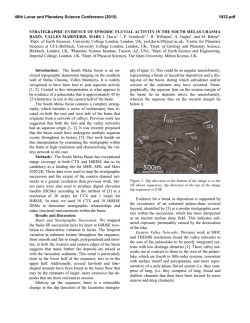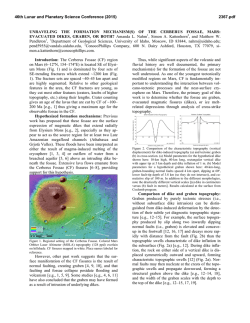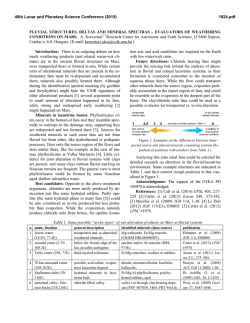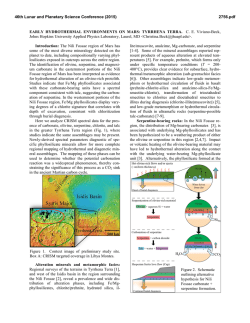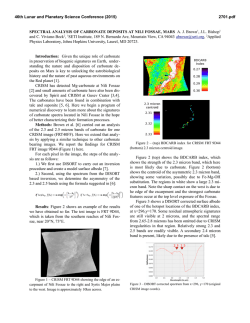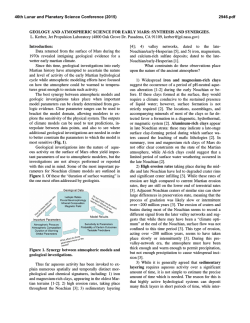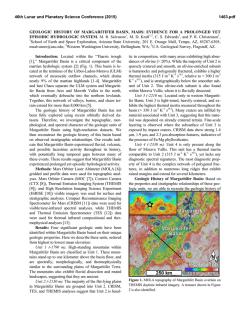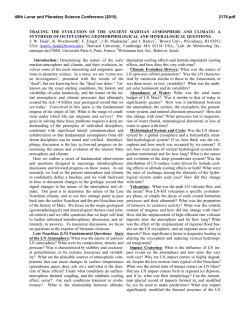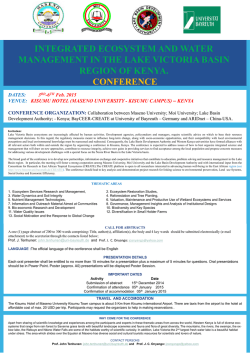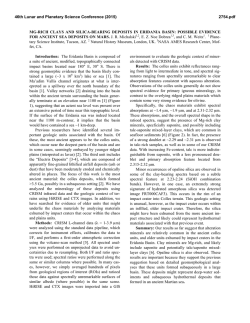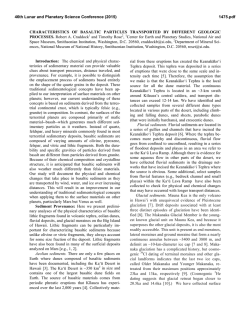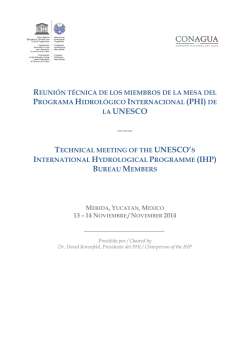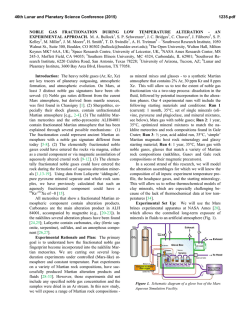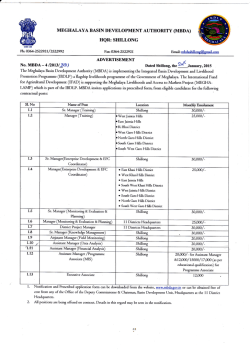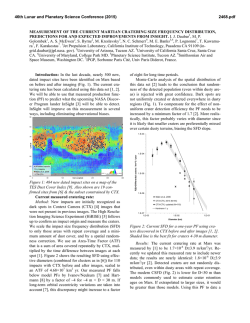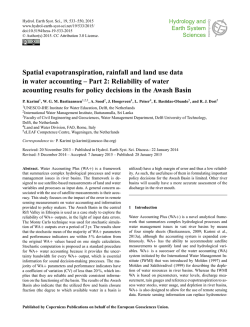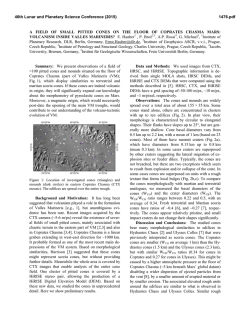
2296
46th Lunar and Planetary Science Conference (2015) 2296.pdf SEDIMENTOLOGY OF A RIVER SYSTEM WITH A SERIES OF DAM-BREACH PALEOLAKES AT IDAEUS FOSSAE, MARS. F. Salese1, G. Di Achille2, G. G. Ori1,3; 1International Research School of Planetary Sciences, Università “G. D’Annunzio”, Pescara, Italy; 2Istituto Nazionale di Astrofisica, Osservatorio Astronomico di Teramo, Italy; 3Ibn Battuta Centre, Universite Cady Ayyad, Marrakech, Morocco. Introduction: Several possible martian paleodrainages and well preserved fluvial and lacustrine deposits have been recognized and studied in the last fifteen years. This work is based on Digital Elevation Model (DEM) derived from CTX and HiRISE stereo images, which enabled the identification of an ancient drainage complex, consisting of i) a nearly 300-km-long valley system located westward of Idaeus Fossae, in Tempe Terra and ii) a series of dam-breach paleolakes. The first part of this system has been dated to the Hesperian-Amazonian by [1]. Here, we present the hydrological reconstruction of the drainage system and a sedimentological study of the series of dambreach paleolakes. Based on geomorphology, sedimentology and terrestrial anologs, the aim of our work is to: a) study the complex channel flow paths draining into Ideaus Fossae after forming a series of dam-breach paleolakes and b) investigate the origin and evolution of this valley system and its implications about climate, tectonic control and potential connection to the putative martian ocean. As it is know from the Earth, Martian paleolakes and deltas give clues on the hydrological conditions during the planet’s history and may provide valuable information about the origin, magnitude and duration of fluid water on the surface [2,3,4,5,6,7]. Study Area: The study area is approximately located on the eastern margin of Tempe Terra, westward of Idaeus Fossae in the Acidalia region, between 33°N and 37°N of latitude and 302°E to 308°E of longitude. We mapped several paleochannels and basins within the region (Fig. 1). Due to the presence of a series of dam-breach paleolakes (five dams in the upper basin and three and two dams in the main and lower basin, respectively) and also considering their asynchronous evolution, we divided the system into four parts: an upper part (hereafter referred to as Upper basin, UB) apparently sourced from fluidized ejecta blankets (FEBs), a central part (hereafter referred to as Main Basin, MB, which coincides with the crater delta depression), an eastern part (hereafter referred to as Lower Basin, LB), and a terminal part (hereafter referred to as Terminal Basin, TB) that flowed into Ideaus Fossae region. The lake chain consists of six open basins (with associated fan-shaped sedimentary deposits) and covers an area of about 2500 sq. km over a E-W stretch of about 100 km. The easternmost and northernmost paleochannels appear to start from fluidized ejecta blankets (FEBs). All the paleochannels in the UB Fig. 3 Fig. 2 Figure 1 ) (top) HRSC nadir mosaic draped on CTX-derived topography of the study area. (bottom) Line drawing and timescale evolution of hydrological activity. were apparently flowing from W/NNW to E and terminate in MB. The MB consist of a 25-km diameter impact crater (Fig. 2) characterized by flat floor, and terraces and the lack of a central peak area. The LB and TB are characterized by a vast avulsive system and an anabranching network. Anastomosing rivers on Mars: The LB and TB of Idaeus Fossae fluvial system represent a very good example of well-preserved anastomosing river system on Mars. In the middle-final part of the TB there is an Oxbow lake, or meander cutoff (Fig. 3). Only one loop is cut off and the lake formed has crescent shaped. The rarity or absence of meander scrolls and oxbow lakes on anastomosing river floodplains, on Earth, was considered to be a fundamental characteristic of anastomosing system in some studies [8, 9]. Anastomosing streams in Idaeus Fossae (LB and TB) have low bank erodibility and medium to high sediment supply as we especially see in the final part of the TB alluvial plains, just before reaching the depression, where the channels are not very deep. This could be due to the fact that usually anastomosing rivers are not fixed in position, and they do not aggrade vertically for long periods, as we can see on the Earth rivers anlogue 46th Lunar and Planetary Science Conference (2015) Ovens and Kings rivers (Australia) they avulse across wide floodplains, causing a variable surface of tipically shallow highs and lows [10] . Interpretation: The six open basins are topographically connected and were likely partially coeval. All drain eastward into a main 25-km-diameter crater-lake forming a complex and multilobate deltaic deposit whose front lies at about 1800-1820 m below the martian datum (Fig. 2). The deltaic deposit is about 8-kmlong and morphologically resembles the Jezero delta, showing a well-developed distributary pattern with evidence of channel switching on the delta plain. The extension and morphology of the fluvio-lacustrine system suggest relatively long (>103 yrs) formation timescales as also supported by the presence of the main fan delta in the central open basin. The overall water source for the 300-km-long fluvial system is unclear, though the occurrence of many rampart craters and the relationships between their ejecta and the channels suggest that subsurface volatiles might have played an important role. Summary and Conclusion: The studied martian paleo-fluvio-lacustrine system shows well preserved fluvial morphologies suggesting its relatively recent formation. Moreover it cuts the NFptm unit and the Amazonian-Hesperian plains according to [1]. Based on terrestrial analogs, if these flows were produced by precipitations due to a terrestrial-like climatic cycle, the deposit would have required thousands of years to form. However, as for the Earth, it is unclear whether anamostosis is a state of transition or an equilibrium fluvial form on Mars. Some investigators interpret anastomosis as an expression of instability induced by climatic change, but not much is known, both on Earth and on Mars, about the response time of river systems to altered hydrological regimes, due to a poor hydraulic understanding of anastomosis. How long could have lasted the anastomosis system of Idaeus Fossae? 2296.pdf Figure 2 ) Close-up of the crater lake, delta and spillover channels from CTX image draped on CTX digital elevation model. The length of time over which the paleovalley fluvial system was formed is uncertain. Nevertheless, on Earth formation of wide alluvial ridges by active channel meandering needs time. On Earth Knighton and Nanson (1993, p. 622) suppose that Cooper Creek has maintained as an anastomosing system for over 50,000 years. Therefore, it is likely that the studied system testifies the occurrence of sustained (in the order of 103 yrs) hydrological activity at Idaeus Fossae during the Hesperian-Amazonian transition. References: [1] Neesemann A. et al. (2014) LPS XLV, 2313. [2] Malin, M. C., & Edgett, K. S. (2003). Science, 302(5652), 1931-1934. [3] Irwin, R. P. et al., (2005). JGR (1991–2012), 110(E12). [4] Di Achille, G. et al. (2006) GRL, 33(7). [5] Kraal, E. R. et al. (2008). Nature, 451(7181), 973-976. [6] Hauber, E. et al. (2009). PSS, 57(8), 944-957. [7] Villiers, G., et al. (2013). JGR, 118(4), 651-670. [8] Smith, D. G. (1983). Modern and ancient fluvial systems, 155-168. [9] Nanson, G. C., & Croke, J. C. (1992). Geomorphology, 4(6), 459-486. [10] Schumm, S. A. et al. (1996). GSA Bulletin, 108(10), 1212-1224. Figure 3 ) Close up of the oxbow lake and after cut-off straight river course from CTX (L) and HiRISE (R) images draped on CTX DEM.
© Copyright 2025
